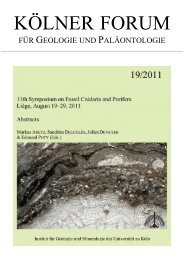Download (6Mb) - USP Electronic Research Repository - The ...
Download (6Mb) - USP Electronic Research Repository - The ...
Download (6Mb) - USP Electronic Research Repository - The ...
Create successful ePaper yourself
Turn your PDF publications into a flip-book with our unique Google optimized e-Paper software.
Benthic Marine Algae of Rotuma Island 429<br />
Arnansia probably does not extend into the Pacific (R.E. Norris, pers. comm.), and hence a<br />
re-examination of all reports of this genus in the region is called for.<br />
Bostrychia Montagne 1842b: 39<br />
Bostrychia tenella (Lamouroux) J . Agardh 1863 (1851-1863): 869; Okamura 1907: 96,<br />
pl. 22, figs 1-13; Weber-van Bosse 1923: 363; Taylor 1960: 599; Durairatnam 1961: 69;<br />
Chapman 1963: 130, fig. 135a, b; Womersley and Bailey 1970: 335; Dawes 1974: 154;<br />
Jaasund 1976: 127, fig. 258; Woelkerling 1976: 116, fig. 133; Tsuda and Wray 1977: 104;<br />
Cribb 1983: 106, pl. 66, figs 3, 4; Lewis 1984: 42; Tseng et al. 1984: 144, pl. 75, fig. 3;<br />
Lewis and Nonis 1987: 22; Silva et al. 1987: 62; King and Puttock 1989: 34; Littler et al.<br />
1989: 174; Tsuda 1991: 48; Coppejans and Prud'homme van Reine 1992a: 189.<br />
Fucus tenellus Vahl 1802: 45 (type locality: St. Croix, Virgin Island).<br />
Plocamium tenellum Lamouroux 18 13: 138 (nomen novum).<br />
(Figs 129, 186)<br />
Plants 5-20 mm high, found as rather soft, dense mosslike clumps; 3 times pinnately<br />
branched with dense bilateral branching near the typically incurved tips. Aggregates almost<br />
black, individual plants dark red to purple, main axis corticated 105-170 bm in diameter,<br />
with 6-8 pericentral cells. Secondary branchlets 35-60 bm in diameter, at 170-200 p,m<br />
intervals along main axis; polysiphonous, corticated below and uncorticated above. Ultimate<br />
branchlets monosiphonous 12-24 p,m in diameter 10-20 cells long with individual cells<br />
8-10 pm long.<br />
Distribution<br />
Fiji, Micronesia, New Caledonia, Solomon Islands, northern Australia, Indonesia, China,<br />
Florida, Caribbean, Brazil, Tanzania.<br />
Fijian Records<br />
Kapraun and Bowden 1978: 201; South and Kasahara 1992: 65; Raj 1993: 49, fig. 14; In<br />
Herb Bishop Museum, Hawaii (BISH 458108,4581 13).<br />
Rotuman Distribution<br />
Paptea (PI/ <strong>USP</strong> 444, *P3/ <strong>USP</strong> S5: 19).<br />
Habitat and Remarks<br />
Found as dense, almost black clumps at the bases of stilt-like roots of mangrove trees<br />
(Bruguiera gymnorhiza) growing in an inland marine swamp about 300 m inland, intermixed<br />
with coconut groves. No other algae were found in this habitat, hence it represented an<br />
isolated population. This species was subsequently found growing on rocks, tree roots and<br />
other objects close to the low tide mark on most Rotuman shores.<br />
As Fucus tenellus Vahl, the intended basionym for Bostrychia tenella, is a later homonym<br />
of F. tenellus Esper (1800: 197, pl. CIX) it is not given priority (see Silva et al. 1987: 62).<br />
Plocamium tenellum Lamouroux is treated as a nomen novum in accordance with Article 72,<br />
Note 1, of the ICBN.<br />
Chondria C. Agardh 18 17: xviii<br />
Key to the Rotuman Species of Chondria<br />
1. Thallus creeping .................................................... C. simpliciuscula<br />
1: Thallus erect ................................................................... .2<br />
2. Plants dark red, up to 30 mm high, main axis to 1.5 mm in diameter ............ C. dasyphylla<br />
2: Plants reddish-purple, up to 40 mm high; main axis 400-500 pm in diameter ....... C. sedifolia

















